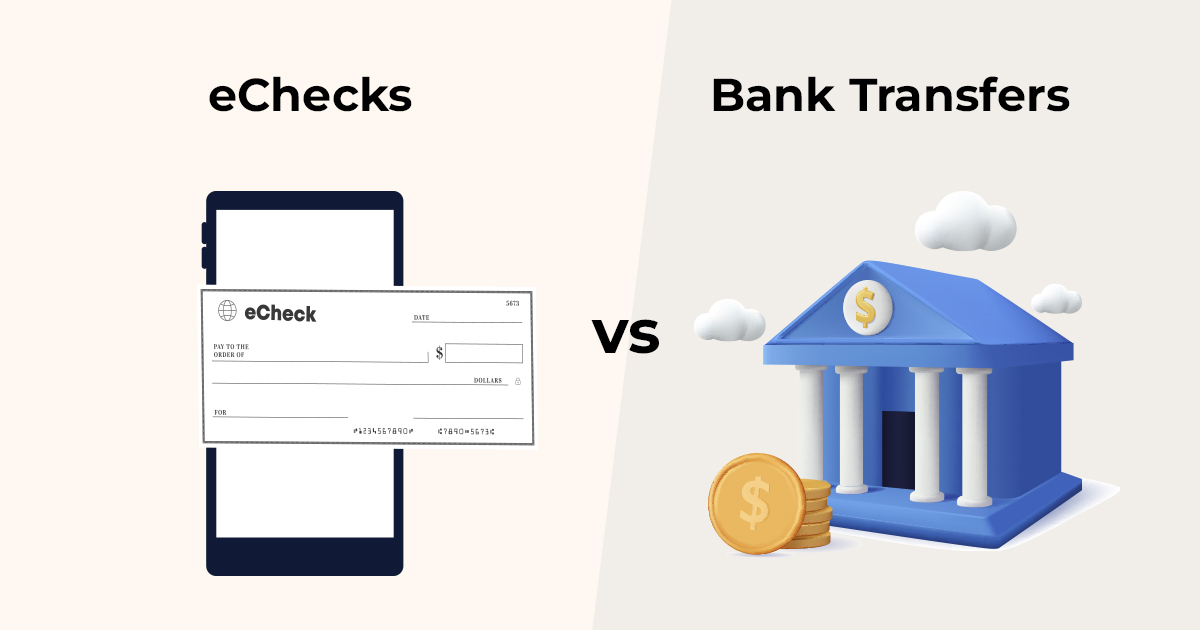
| January 22nd, 2024 |
Navigating Digital Finances — eChecks vs. Traditional Bank Transfers Unveiled!
In the ever-evolving landscape of digital finance, individuals and businesses have an array of options when it comes to transferring funds. Two prominent contenders in this realm are eChecks and Traditional Bank Transfers. Understanding the pros and cons of each method is crucial for making informed decisions about financial transactions. In this blog, we delve into the intricacies of eChecks and Traditional Bank Transfers to help you navigate the digital financial landscape.
eChecks — Pros:
Convenience and Speed:
eChecks offer a swift and convenient alternative to traditional paper checks. Transactions are processed electronically, reducing the time and effort required for physical processing.
Cost-Effective:
Compared to traditional bank transfers, eChecks are often more cost-effective. They eliminate the need for paper, postage, and manual processing, leading to potential cost savings for both individuals and businesses.
Security Measures:
eChecks come equipped with robust security measures, including encryption and authentication protocols. This ensures a high level of security during the transmission and processing of financial information.
Recordkeeping:
Digital transactions inherently provide a better platform for recordkeeping. eChecks facilitate easy tracking and monitoring of financial transactions, offering a digital trail that simplifies auditing and accounting processes.
Accessibility:
eChecks can be initiated and received through online banking platforms, making them accessible from virtually anywhere with an internet connection. This accessibility enhances the flexibility of financial transactions.
eChecks — Cons:
Learning Curve:
Transitioning to eChecks may pose a learning curve for individuals and businesses accustomed to traditional methods. Familiarizing oneself with the digital interface and security protocols is essential to leverage the benefits effectively.
Dependence on Technology:
As with any digital transaction method, eChecks depend on technology. Issues such as system outages, internet connectivity problems, or cybersecurity threats can disrupt the seamless flow of transactions.
Transaction Limits:
Some financial institutions may impose transaction limits on eChecks, which could be a constraint for businesses involved in high-volume transactions. It’s essential to be aware of and plan around these limitations.
Fraud Risks:
While eChecks have robust security measures, no system is entirely immune to fraud. Users must remain vigilant and adopt best practices to mitigate the risk of fraudulent activities, such as phishing scams.
Traditional Bank Transfers — Pros:
Widespread Acceptance:
Traditional bank transfers are universally accepted, providing a reliable and standardized method for transferring funds. This widespread acceptance makes them a preferred choice for international transactions.
Established Trust:
The long-standing history of traditional bank transfers instills a sense of trust among users. Many individuals and businesses are more comfortable relying on a system with a proven track record.
No Learning Curve:
Unlike newer digital methods, traditional bank transfers have been in use for decades. Users are already familiar with the process, and there is no need for additional training or acclimatization.
Direct Account-to-Account Transactions:
Traditional bank transfers typically involve direct account-to-account transactions, minimizing the need for intermediaries. This direct transfer enhances the speed and efficiency of transactions.
High Transaction Limits:
Traditional bank transfers often come with higher transaction limits compared to some digital methods. This makes them suitable for businesses or individuals engaged in substantial financial transactions.
Traditional Bank Transfers — Cons:
Time-Consuming:
One of the primary drawbacks of traditional bank transfers is the time required for processing. International transfers, in particular, can take several days, impacting the speed of financial transactions.
Transaction Costs:
Traditional bank transfers may involve higher transaction costs, especially for international transfers. Various fees, including wire transfer fees and currency conversion charges, can accumulate and affect the overall cost-effectiveness.
Limited Recordkeeping:
While advancements have been made in online banking, traditional bank transfers may lack the detailed recordkeeping capabilities of digital methods. Users may need to maintain additional documentation for auditing purposes.
Inflexibility:
Traditional bank transfers may lack the flexibility provided by newer digital methods. The process is often more rigid, with limited options for customization or expedited processing.
Risk of Errors:
The manual nature of some traditional bank transfer processes increases the risk of errors. Incorrect information, such as an account number or routing number, can lead to delays and complications.
Conclusion — Striking the Balance:
As we navigate the digital frontier of financial transactions, it’s clear that both eChecks and Traditional Bank Transfers have their merits and drawbacks. The choice between them depends on individual preferences, specific use cases, and the level of technological adoption within a given context.
For those valuing speed, cost-effectiveness, and advanced recordkeeping, eChecks present an attractive option. However, users must be willing to embrace the learning curve and remain vigilant against potential fraud risks.
On the other hand, Traditional Bank Transfers offer a time-tested and widely accepted method, especially for international transactions. The established trust and familiarity make them a preferred choice for those seeking reliability, even though they may come with higher transaction costs and processing times.
Ultimately, the ideal approach may involve striking a balance between these methods. Users can leverage the strengths of each system based on the specific requirements of their transactions. As the financial landscape continues to evolve, staying informed about the pros and cons of different transaction methods will empower individuals and businesses to make sound financial decisions in the digital age.
